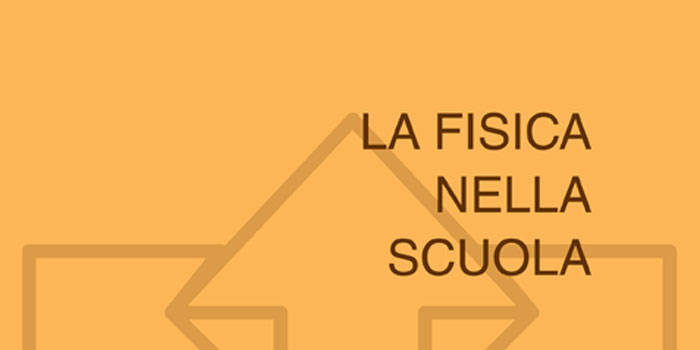Articoli rivista
Didattica
 Anno XLIX - n.3 - luglio/settembre 2016
Anno XLIX - n.3 - luglio/settembre 2016 Ottica geometrica rivisitata
A simple and intuitive model of the functioning of mirrors and lenses is proposed. This model could profitably integrate the traditional way of teaching this topic. The purpose is to make it more effective by giving students a physical interpretation of the way these devices affect light beams. […]
 Anno XLIV - n.2 - aprile/giugno 2011
Anno XLIV - n.2 - aprile/giugno 2011 Perché la bicicletta è vantaggiosa?
Body energy transfers while walking and cycling are analysed and compared, showing why riding a bicycle is energetically more efficient than walking. […]
 Anno XLVIII - n.2 - aprile/giugno 2015
Anno XLVIII - n.2 - aprile/giugno 2015 Perché la Terra è sferica, o quasi?
The shape of some astronomical bodies of different size is taken into consideration and qualitatively explained on a gravitational-electromagnetic interaction ground. […]
 Anno XXX - n.3 - luglio/settembre 1997
Anno XXX - n.3 - luglio/settembre 1997 Possibili effetti di radiazioni ionizzanti presenti in vecchi orologi
Small low intensity doses con be produced by some watches made in the period 1950-1960 by the presence of Ra-226 in the hands and some parts of the dials. The exent of the possible effects on the wearer of such watches is evaluated in this article, […]
 Anno LIV – n.2 – aprile/giugno 2021
Anno LIV – n.2 – aprile/giugno 2021 Pregiudizi di conferma in fisica: due varianti cui prestare attenzione
A fronte della necessità di un maggiore sforzo per sviluppare le attitudini critiche negli alunni e negli studenti, questa nota si concentra su uno dei pregiudizi cognitivi che spesso sono di ostacolo in questa materia. Nella sua forma più tipica, questo pregiudizio consiste nella propensione a validare un᾽argomentazione perché si presume che la sua conclusione sia corretta. […]
 Anno XXVIII - n.1 - gennaio/marzo 1995
Anno XXVIII - n.1 - gennaio/marzo 1995 Problema dei due corpi e piccole oscillazioni
The purpose of this article is to get the student acquainted with simple mathematical techniques allowing her (him) to investigate some basic properties of keplerian motion. […]
 Anno LI - n.3-4 - luglio/dicembre 2018
Anno LI - n.3-4 - luglio/dicembre 2018 Proposte di percorsi didattici di spettroscopia ottica e analisi dei risultati sull’apprendimento degli studenti
An educational path on optical spectroscopy was elaborated as a bridge between classical and modern physics and centered on the interpretation of optical spectra in laboratory mode for upper secondary school students. The proposal was developed as part of a PhD research in physics education in the theoretical framework of the Model of Educational Reconstruction (MER) and employing Design-Based Research (DBR) methodology which implies an iterative revision of the implemented intervention modules experimented in classroom. […]
 Anno XLV - n.1 - gennaio/marzo 2012
Anno XLV - n.1 - gennaio/marzo 2012 Quanta energia è irradiata scaricando un condensatore?
Reasoning on what happens when connecting two charged capacitors suggests a general procedure for evaluating the energy associated with the propagation of electromagnetic waves. […]
 Anno XXVIII - n.2 - aprile/giugno 1995
Anno XXVIII - n.2 - aprile/giugno 1995 Quanti sono gli elettroni di conduzione nei metalli?
We test experimentally the free electron gas model for electric conduction in metals by means of measurements of the Hall coefficient. Full details for the construction of the experimental apparatus are given. […]
 Anno XLV - n.2 - aprile/giugno 2012
Anno XLV - n.2 - aprile/giugno 2012 Quei testi dell’Apocalisse. Legge dell’apprendimento iperbolico
In recent years the knowledge levels in science of freshmen dropped constantly in Italy and in other countries. This might be because the excess of information in today?s secondary school textbooks makes identifying and mastering the important concepts difficult. Results found by different groups that examined pre-university textbooks in a number of different countries are reported. […]
 Anno XXVIII - n.3 - luglio/settembre 1995
Anno XXVIII - n.3 - luglio/settembre 1995 Rappresentazione grafica delle incertezze sui dati sperimentali mediante l’uso del foglio elettronico LOTUS 123
This article deals how to represent the experimental data with their absolute error with Lotus 123 […]